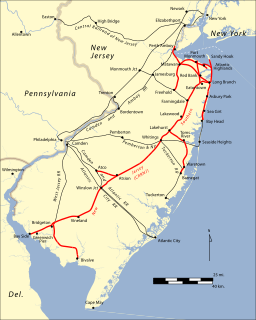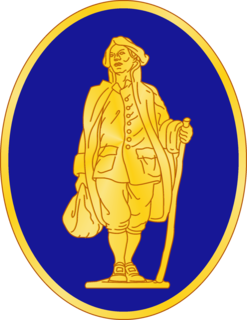
Barnegat Township is a township in Ocean County, New Jersey, United States. As of the 2010 United States Census the township's population was 20,936, reflecting an increase of 5,666 (+37.1%) from the 15,270 counted in the 2000 Census, which had in turn increased by 3,035 (+24.8%) from the 12,235 counted in the 1990 Census. The 2010 population was the highest recorded for the township in any decennial census.

Barnegat Light is a borough in Ocean County, New Jersey, United States. As of the 2010 United States Census, the borough's population was 574, reflecting a decline of 190 (-24.9%) from the 764 counted in the 2000 Census, which had in turn increased by 89 (+13.2%) from the 675 counted in the 1990 Census. The borough borders the Atlantic Ocean on Long Beach Island and is home to Barnegat Lighthouse.

Stafford Township is a township in Ocean County, New Jersey, United States. As of the 2010 United States Census, the township population increased to 26,535, reflecting an increase of 4,003 (+17.8%) from the 22,532 counted in the 2000 Census, which had in turn increased by 9,207 (+69.1%) from the 13,325 counted in the 1990 Census. The 2010 population was the highest level ever recorded in a decennial census for Stafford Township.
Route 72 is a state highway in the U.S. state of New Jersey. It runs 28.74 mi (46.25 km) from the Four Mile Circle with Route 70 in Woodland Township in Burlington County to County Route 607 in Ship Bottom on Long Beach Island in Ocean County. Route 72 travels through the Pine Barrens as a two-lane undivided road. After an interchange with the Garden State Parkway, the route becomes a four- to six-lane divided highway through built-up areas of Manhawkin and crosses the Manahawkin Bay via the Manahawkin Bay Bridge onto Long Beach Island.

Barnegat Bay is a small brackish arm of the Atlantic Ocean, approximately 42 miles (68 km) long, along the coast of Ocean County, New Jersey in the United States. It is separated from the Atlantic by the long Barnegat Peninsula, as well as by the north end of Long Beach Island, popular segments of the Jersey Shore. The bay is fed by several small rivers, including the Toms River and Metedeconk River, which empty into the bay through small estuaries along its inner shore. The communities of Toms River, Silverton, and Forked River sit along the river estuaries on the bay.

Long Beach Island is a barrier island and summer colony along the Atlantic Ocean coast of Ocean County, New Jersey in the United States. Aligned north to south, the northern portion has generally more expensive low-density housing, whereas the southern portion possesses higher-density housing and considerable commercial development. Long Beach Island is less than one mile away from mainland New Jersey. The primary industries include tourism, fishing, and real estate. The only access point to the island by land is a single causeway.

Titus Cornelius, also known as Titus, Tye, and famously as Colonel Tye, was a slave of African descent in the Province of New Jersey who fought as a Black Loyalist during the American Revolutionary War; he was known for his leadership and fighting skills. He fought with a volunteer corps of escaped Virginia Colony slaves in the Ethiopian Regiment and the "Black Brigade" associators. Tye died from tetanus and lockjaw from a musket wound in the wrist following a short siege in September 1780 against Captain Joshua Huddy. Tye was one of the most feared and effective guerrilla leaders opposing the American patriot forces in central New Jersey.

Joshua "Jack" Huddy, the commander of a New Jersey Patriot militia unit and a privateer ship during the American Revolutionary War, was noted as a figure of controversy after he was executed by irregular forces of the Associated Loyalists. He had been twice captured by Loyalist forces, escaping after the first time.

The Battle of Springfield was fought during the American Revolutionary War on June 23, 1780, in Essex County, New Jersey. After the Battle of Connecticut Farms, on June 7, 1780, had foiled Lieutenant General Wilhelm, Baron von Knyphausen’s expedition to attack General George Washington’s army at Morristown, New Jersey, Knyphausen and Lieutenant General Sir Henry Clinton, British commander-in-chief in North America, decided upon a second attempt. Although the British were initially able to advance, they were ultimately forced to withdraw in the face of newly arriving rebel forces, resulting in a Continental victory. The battle effectively ended British ambitions in New Jersey.

As the location of many major battles, New Jersey was pivotal in the American Revolution and the ultimate victory of the American colonists. This important role earned it the title of Crossroads of the American Revolution.

"Pine Robbers" were loosely organized, criminal, gangs and marauders who were British sympathizers and Loyalists during the American Revolutionary War and used the Pine Barrens of New Jersey to wreak havoc in the area. The pine barrens created densely forested terrain where concealment of guerrilla and criminal activities could easily be carried out.

The Northern theater of the American Revolutionary War after Saratoga consisted of a series of battles between American revolutionaries and British forces, from 1778 to 1782 during the American Revolutionary War. It is characterized by two primary areas of activity. The first set of activities was based around the British base of operations in New York City, where each side made probes and counterprobes against the other's positions that sometimes resulted in notable actions. The second was essentially a frontier war in Upstate New York and rural northern Pennsylvania that was largely fought by state militia companies and some Indian allies on the American side, and Loyalist companies supported by Indians, British Indian agents, and occasionally British regulars. The notable exception to significant Continental Army participation on the frontier was the 1779 Sullivan Expedition, in which General John Sullivan led an army expedition that drove the Iroquois out of New York. The warfare amongst the splinters of the Iroquois Six Nations were particularly brutal, turning much of the Indian population into refugees.

In the American Revolution, gaining freedom was the strongest motive for Black enslaved people who joined the Patriot or British armies. It is estimated that 20,000 African Americans joined the British cause, which promised freedom to enslaved people, as Black Loyalists. Around 9,000 African Americans became Black Patriots.

The Tuckerton Railroad was a railroad that operated in New Jersey from 1871 to 1936. The Southern New Jersey Railroad operated part of the line from 1937 to 1940.
The Ethiopian Regiment, better known as Lord Dunmore's Ethiopian Regiment, was a British colonial military unit organized during the American Revolution by the Earl of Dunmore, last Royal Governor of Virginia. Composed of formerly enslaved people who had escaped from Patriot masters, it was led by British officers and sergeants. The regiment was disbanded in 1776, though many of its soldiers probably went on to serve in other Black Loyalist units.

Associators were members of 17th- and 18th-century volunteer military associations in the British American thirteen colonies and British Colony of Canada. These were more commonly known as Maryland Protestant, Pennsylvania, and American Patriot and British Loyalist colonial militias. But unlike militias, the associator military volunteers were exempt from regular mandatory military service. Other names used to describe associators were "Associations", "Associated", "Refugees", "Volunteers", and "Partisans".
William "Bloody Bill" Cunningham (1756–1787) was an American loyalist infamous for perpetrating a series of bloody massacres in South Carolina's backcountry in the fall of 1781 as commander of a Tory militia regiment in the Revolutionary War. Though his family were loyal to the British crown, Cunningham initially enlisted in the Continental Army as part of the State of South Carolina's 3rd regiment in 1775. His tenure in the rebel army was an unhappy one and Cunningham changed sides to fight for the British in 1778. He earned the nickname "Bloody Bill" for the violent, ruthless nature of his raids on rebels and patriot civilians.

Colonists who supported the British cause in the American Revolution were Loyalists, often called Tories, or, occasionally, Royalists or King's Men. George Washington's winning side in the war called themselves "Patriots", and in this article Americans on the revolutionary side are called Patriots. For a detailed analysis of the psychology and social origins of the Loyalists, see Loyalist.

The Cedar Bridge Tavern is a historic building located in the New Jersey Pine Barrens in Barnegat Township. It was built around 1740 and is believed to be the oldest intact bar in the United States. It is located at the site of the last skirmish of the American Revolutionary War. It is on the National Register of Historical Places.
Asher Holmes was an American politician and veteran of the American Revolution.

















